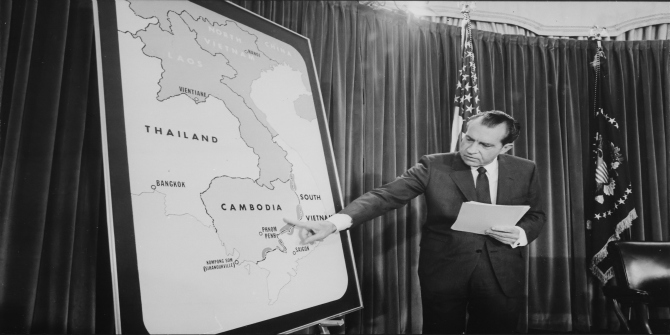 In the aftermath of the Asian financial crisis of 1997, many expected the affected countries to reform and restructure their financial systems and become more market-driven. There was an expectation that Asian economies would retrench state influence in the market and converge onto a liberal market model. This book investigates the evolution of the financial systems of Korea, Malaysia, and Thailand since 1997. Pierpaolo Perna is impressed by the book’s ability to draw a parallel between the East Asian experience and the financial crisis still affecting a large segment of the Western world today.
In the aftermath of the Asian financial crisis of 1997, many expected the affected countries to reform and restructure their financial systems and become more market-driven. There was an expectation that Asian economies would retrench state influence in the market and converge onto a liberal market model. This book investigates the evolution of the financial systems of Korea, Malaysia, and Thailand since 1997. Pierpaolo Perna is impressed by the book’s ability to draw a parallel between the East Asian experience and the financial crisis still affecting a large segment of the Western world today.
Financial Crisis and Institutional Change in East Asia. Jikon Lai. Palgrave Macmillan. June 2012.
Since 2008, the financial turmoil in the Western world has brought into question the role of the state in countering and preventing adverse systemic shocks. Since economic policymaking does not exist within an institutional vacuum, it therefore remains vital to investigate the evolution of the incentive structures governing decision making at the political and business levels. Building upon this intuition, Jikon Lai frames his analysis of institutional change in East Asia within the Varieties of Capitalism (VoC) literature, focussing on how institutional diversity impacts economic outcomes. Lai compares and assesses the role of the state in reforming financial systems in Malaysia, Korea and Thailand as a result of the 1997 Asian financial crisis. More ambitiously, the author claims his analysis allows us to draw an interesting parallel with the global financial crisis in Europe and the US, epitomised by the collapse of Lehman Brothers and Merrill Lynch in 2008-9.
What are the key features which characterise financial systems in capitalist economies? This is the first broad question that Lai attempts to answer. Lai argues that once the ‘ideal-types’ in capitalism are established these can be used as a benchmark from which to assess the progress of Asian economies post-crisis. In his view, the first dimension to consider is access to credit. Whether or not credit is granted based on impersonal price signals, or non-market factors such as inside networks and informal relationships, uniquely identifies a financial system.
Secondly, distinctions are to be made between bank-based and market-based systems. While the former reduce post-lending opportunistic behaviour through a system of close relationships between financial institutions and borrowers, the latter rely on market indicators to reward the most profitable projects that demand financing. The third defining dimension is the extent to which foreign actors affect domestic decisions; this, as we will see, can prove decisive in shaping institutional paths, together with transparency in regulatory measures and the level of state ownership.
This brief account may suggest a dichotomous view of market economies, that is, that the ideal types these spectra generate are only two. On one end, sits the liberal type associated mainly with Western Anglophone countries; on the other – the coordinated type characterised by state’s predilection for those powerful business and employer associations that play strategic roles in the national economy. The novelty in Lai’s approach rests with his introduction of a “mid-spectrum” ideal type which he claims serves as a better benchmark for East Asian economies. Broadly speaking, this developmental model aims to typify state-influenced market economies, characterised by a strong focus on industrial policies to promote growth, a particularly strong organisational capability of state institutions and ideological elements driving policy change. In the financial sector, such model presupposes government control over interest rates and credit allocation, hence powerful influence over the pattern of investment. If needed, governments can act as lenders of last resort in strategic sectors.
How does this very comprehensive yet analytical framework affect Lai’s assessment of East Asian economies? Three chapters are devoted to outlining the history and evolution of financial systems in the wake of the crisis of 1997, which prompted important institutional reforms.
Before the crisis, South Korea was one of the most important examples of a state-regulated economy. In particular, finance was a major instrument of industrial policy, thanks to a subordinated central bank, strict rules for credit allocation, and nationalised commercial banks. Following wage and price inflation in 1979-80, the government had to remedy with liberalisation policies by lowering entry barriers and expanding the range of authorised financial activities. Further reforms have been implemented since 1993, yet this did not prevent political elites from actively interfering with appointment decisions of top executives. According to Lai, these measures indicate a gradual shift towards the liberal market ideal-type, although rent-seeking behaviour and sporadic attempts by bureaucracy to intervene in the financial markets remain. In light of the reforms that took place in the Western World following the 2008 crisis, this case study calls for an in depth reflection on what causes financial crises and whether cures are often no more problematic than diseases, since the former have often failed to break up those entrenched relations between political and economic elites that put sand in the wheels of a fully functioning capitalist system.
Malaysia, on the other hand, emerged from the financial crisis relatively unscathed. Lai suggests that low exposure of domestic banks and corporations to foreign borrowing as well as effective regulation contributed to shielding the economy from the crisis. This allowed Malaysian government to put in place liberalisation measures in the post-crisis period that fostered financial growth and opened up the market to foreign investors. This process, however, cannot be understood without accounting for the role played by various interest groups characterised by racial and business features; despite convergence to a liberal market model, political patronage and arbitrary redistribution emerged as a by-product of institutional change. It is interesting to observe how conservative lending practices may have the unintended effect of shielding from the most direct effects of the crisis. Similar dynamics were also present in Europe when the 2008 financial crisis struck. Yet, it may be noted how European institutions faced greater obstacles in countering financial shocks and were less prone to opening up the economy as an anti-cyclical measure.
Quite the opposite occurred in Thailand, in which state control over the financial sector increased as a result of the crisis, causing a shift from a liberal to an increasingly state- influenced economic model. Before the collapse of the Securities Exchange of Thailand and a major finance company, the state “influenced but did not govern” the financial sector. The Banking Act in 1979 instead imposed formal controls of finance companies, providing the Bank of Thailand with additional instruments of monetary control, partly due to strong political demands. As a result, in 2009 the Thai government found itself owning 41 percent of the total assets in the commercial banking sector, despite long term growth in the capital market and increased participation of foreign actors.
Different capitalist systems react to financial shocks in unexpected ways: very often, the remedies that result from the interaction of the interests of political elites, voters, and regulated business areas are contingent on the status quo and often surprisingly diverse. From this broad review we can catch a glimpse of the comprehensiveness of Lai’s analysis, which is an important academic contribution and an in-depth account of institutional change in East Asia since 1997. The underlying message is that the East Asian experience is still relevant to the Western world, and can help us both predict and understand today’s drivers of change in the global financial system.
————————————————————————
Pierpaolo Perna is a MPA student in Public and Economic Policy at the LSE, having graduated with First Class Honours in Economics and Politics from the University of London. During his undergraduate studies, he took part in various economic research activities and was a visiting student at Peking University, China. His research interests include political economy, public and labour economics. Read more reviews by Pierpaolo.






